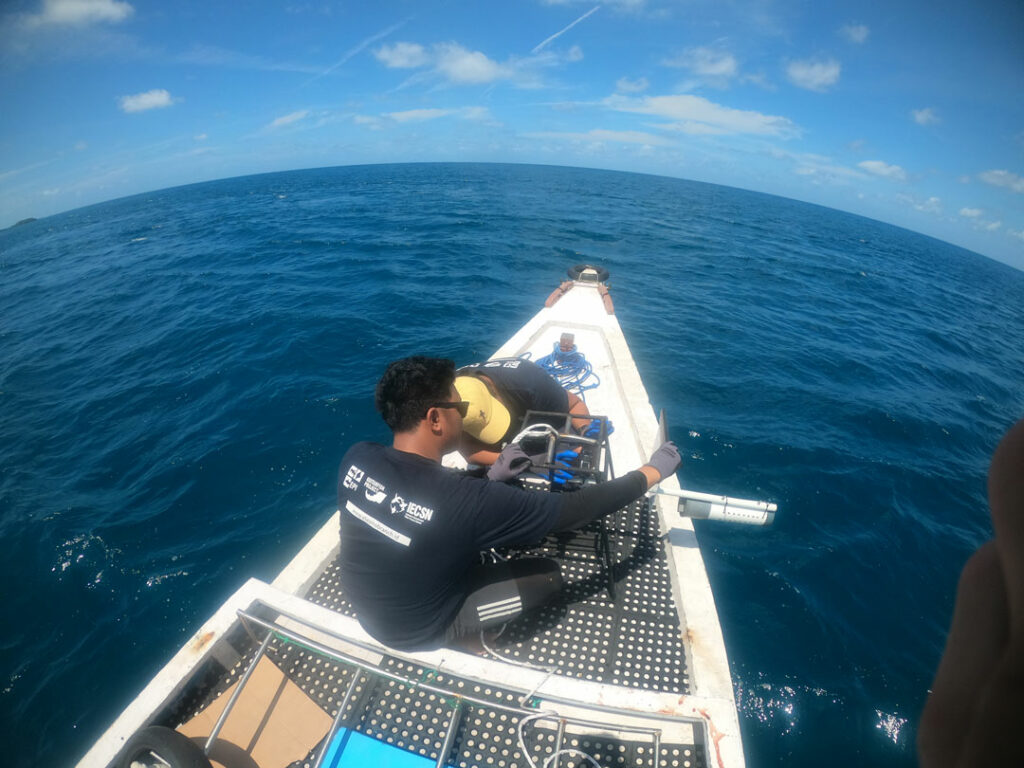More than just giant guitarfish
Sister species and predatory competition of the sandy waters
The Elasmobranch Project Indonesia (EPI)’s team has been exploring the seafloor of Karimunjawa National Park (KJNP) and nearby waters for several months in 2022. As much as they expected that there would be other species captured in their survey with the Baited Remote Underwater Video (BRUV), they were still pretty surprised by what they encountered in the videos. As KJNP is located in the middle of the Java Sea, the species encountered were actually common species distributed there. However, encountering them in the national park gave the team a spark to hope that KJNP has the potential to protect these elasmobranch species.

Exploration process using Baited Remote Underwater Videos (BRUV) to locate Giant Guitarfish. Photo © Faqih Akbar Alghozali
As KJNP is famous for its thriving coral reefs, it was not too surprising for the team to be gifted with some reef predator species, albeit deploying the majority of their BRUVs in the sand bed area as they were looking for giant guitarfish. Sea turtles were common passersby as they swam from reef to reef. The team only encountered the green and hawksbill turtles, as described by the KJNP Agency that these two were the only sea turtle species in the national park. More common and fiercer predators were also seen, including the great barracuda and giant moray, which were also the most persistent in trying to open the bait canister, as commonly seen in BRUV research.

Green Turtle (left), Giant Moray (middle), and Great Barracuda (right) encountered in BRUV deployed in Karimunjawa National Park. Photo © BRUV-EPI
Some blacktip reef sharks were also seen passing in front of the cameras, although showing no interest in the bait compared to the previous two mentioned. The surprises came as the vulnerable sicklefin weasel and the endangered snaggletooth shark (Hemipristis elongata) decided to show up to inspect the bait. Big ray species, including the ocellated eagle ray, blotched fantail ray, mangrove whipray, pink whipray, and honeycomb whipray, also felt the need to appear in front of the camera during the exploration.
The team exploded with excitement when the first giant guitarfish finally swam across the BRUV deployed near one of the no-take zones in the national park. Further happiness hit the team as several others exposed themselves to the cameras. Just like other elasmobranch species, some were accompanied by small sharksuckers. The sister of the giant guitarfish stepped up to the stage to take over the show. Bigger in size and with a huge number of symbionts, the first critically endangered bottlenose wedgefish slowly swam across the BRUV with a gang of cobias. It was even more ecstatic to the team as several individuals also came to dance around other deployed BRUVs.
The findings described several species that may provide predatory competition to both giant guitarfish and wedgefish in KJNP. Additionally, fishing pressures that still exist as a threat to these species may not do well if the species want to compete well with the other predators. However, the team believed this finding is a great start to conservation efforts on these two species in KJNP. As of the present time, the presence of some big individuals of these critically endangered species and the existence of KJNP as an MPA, provide hope for scientist, conservation practitioners, local communities, and governments to protect the species from extinction, at least in the national park.

Giant Guitarfish (left) and Bottlenose Wedgefish (right) encountered in BRUV deployed in Karimunjawa National Park. Photo © BRUV-EPI
